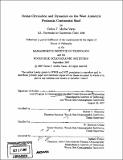Ocean circulation and dynamics on the west Antarctic Peninsula continental shelf
Author(s)
Moffat Varas, Carlos F
DownloadFull printable version (39.62Mb)
Other Contributors
Woods Hole Oceanographic Institution.
Advisor
Robert C. Beardsley and W. Brechner Owens.
Terms of use
Metadata
Show full item recordAbstract
Observations of current velocity, temperature, salinity and pressure from a 2-year moored array deployment and four hydrographic cruises conducted by the United States Southern Ocean GLOBEC program on the western Antarctic Peninsula continental shelf are used to characterize the ocean circulation and its connection to fresh water and heat fluxes on the shelf. Mean velocities on the shelf are of the order of 5 cm/s or less. Tidal motions are dominated by the M2 and S2 semi-diurnal tides and the 01 and K1 diurnal tides, although the tidal velocities are typically less than 2 cm/s. Near-inertial motions are relatively large, with current velocities as high as 26 cm/s. It is shown that Marguerite Trough, a large bathymetric feature connecting the shelf-break to Marguerite Bay, plays a critical role in determining the circulation. The mean flow is strongly steered in the along-slope direction, and the tidal currents also show increasing current polarization at depth in Marguerite Trough. At time-scales of 5 to 20 days, the observations show bottom-intensified motion in Marguerite Trough consistent with bottom-trapped topographic Rossby waves. (cont.) The subtidal circulation in the trough has a significant wind-driven component in Marguerite Trough, with downwelling-favorable winds forcing cross-shelf flow on the northern side of the trough and along the shore on the outer shelf. Upwelling-favorable winds force roughly the opposite circulation. The cyclonic circulation on the trough helps advect blobs of salty, warm and nutrient-rich water across the shelf. These intrusions are small (;4 km) and frequent (4 events/month). Also, the Antarctic Peninsula Coastal Current (APCC), a coastal buoyant current which is described for the first time here. The APCC is a seasonal current which is only present during the ice-free season and is forced by freshwater fluxes associated with large glacier melt and precipitation rates in the region.
Description
Thesis (Ph. D.)--Joint Program in Applied Ocean Science and Engineering (Massachusetts Institute of Technology, Dept. of Earth, Atmospheric, and Planetary Sciences; and the Woods Hole Oceanographic Institution), 2007. Includes bibliographical references (p. 177-186).
Date issued
2007Department
Joint Program in Applied Ocean Physics and Engineering; Woods Hole Oceanographic Institution; Massachusetts Institute of Technology. Department of Earth, Atmospheric, and Planetary SciencesPublisher
Massachusetts Institute of Technology
Keywords
Earth, Atmospheric, and Planetary Sciences., /Woods Hole Oceanographic Institution. Joint Program in Applied Ocean Science and Engineering., Woods Hole Oceanographic Institution.